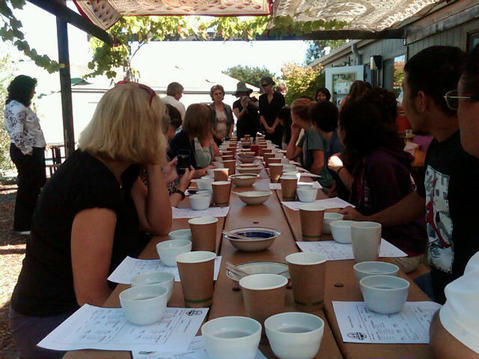
1. Dark roasts typically have less acidity while lighter roasts have more since they retain more of their natural flavors.
2. Hence, darker roasts mask the flavor more making it harder to notice the different notes of the bean., i.e. fruity, herby, etc.. When they say "Charbucks," it basically means that Starbucks has really dark coffee; some may even say burnt. By not allowing more of the coffee's natural flavors to show through, Starbucks can obtain the uniformity they need across the globe for quality control..
3. If you ask the barista for a full-body coffee, it doesn't necessarily mean you are asking for a dark roast. Body refers to the weight or viscosity of a coffee. Our Master Cupper, Sarah Crosby-Baker of Santa Cruz Coffee Roasting, compared "body" to the difference you feel when you drink whole milk vs.skim milk...one is thicker than the other on your tongue.
4. Kona coffee is not more expensive because its exotic or any more special. It's because it is grown on US soil where workers have to be paid a fair wage and be covered for workman's comp and payroll taxes. Sounds like what the fair-trade model is trying to do for coffee grown in developing countries. If more people knew that, they would understand the concept of fair trade a bit better.
5. Just like there is seasonality within fruits and vegetables there is seasonality with coffee. Just because coffee is grown in a temporal climate doesn't mean it can grow year-round. Some roasters are starting to pay more attention to this cycle and only offer certain regional varieties when they are in season. The typical harvest for Mexico and Central America is b/w Oct-Dec. bringing those beans to market by March or April. If stored properly, raw beans can last in cool storage but better when it is fresh.
A bit more on the coffee we tried...A large part of the Community Agroecology Network's (CAN) model is their fair trade coffee program where they work with small-scale coffee farmer cooperatives in Mexico and Central America. Unlike some fair trade brands, CAN along with other coffee cooperatives like Cooperative Coffees, cut out even more middle men traveling straight from grower to roaster. It develops long-term relationships with community based partners and ensures a fair price for the coffee farmer. CAN's innovative approach involves UCSC students and researches who nurture this international network and its commitment to building sustainable rural livelihoods. What they bring back is a story about the coffee, the people and the project. Instead of a nutrition table, there is a "sustainability facts" label telling you about the coffee's origin as well as the social and economic factors of the region. You can order CAN coffee online, click here!
Will leave you with one last, fun act...If you didn't know (I didn't), Ethiopia is the birthplace of coffee - true story. The story goes that a shepherd noticed his goats were acting a little zanny after eating a certain berry. He figured the berry must have some intoxicating properties and processed the bean into a drinkable substance...presto chango, coffee!

 RSS Feed
RSS Feed
